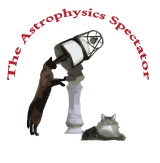
The basic layout of the site is as survey paths, which can be found under the Surveys link at the top of this and most other pages on this site. Each survey begins with a basic overview of the subject. Part of this overview include simulators of astrophysical phenomena that allow the reader to experiment with the phenomena. The later pages in a survey present the subject in greater and more mathematical depth. A path ends with research pages that describe current research projects and results in astrophysics.
The links at the top of each page are Home, which is the current home page of this site, Commentary, which is an index of short essays on topics loosely related to astrophysics, Surveys, which is the index of survey paths, Research, which is the index of research pages and the page leading to recent news items, Background, which is the index page for all background information on astrophysics, including survey pages, simulator pages, tables, bibliographic references, and lists of web resources, Previously, which is an index of previous home pages, and Site Info, which describes the site and its author, and gives contact information.
On the home page is found an addition link. This is the Store link, which leads to reviews of worthwhile books on astronomy and other relates subjects. Links on these pages enable the reader to buy these books from Amazon.com, which helps to financially sustain this web site.
Each Wednesday, a new issue of The Astrophysics Spectator is published that comprises a new home page, a new commentary, whatever news the author notices, and background, research, and simulator pages added to the survey paths. The home page acts as an index to the newly added pages. This site also has an RSS channel, whose link is given at the bottom of the right-hand column of this page.
July 13, 2005
The hopes and the realities of studying neutron stars are described in a new page on the “X-ray Astronomy” survey path.
A neutron star is the remnant of a massive star that has undergone a supernova. Created when the core of a massive star collapses to about 10 km in size, the neutron star has the density of an atomic nucleus. What is this material like? Many theories describe matter at this extreme density, starting with the theory that the core of these stars are free protons and neutrons, and extending to more exotic theories that fill the core of the neutron star with fundamental particles, such as muons or quarks. But how do we test these theories?
One method of testing the theories is to find the relationship between a neutron star's radius and its mass. The relationship between mass and radius is a measure of the stiffness—the change in pressure with density—of the star's interior, which is a quantity that differs from theory to theory. In principle, if we can measure a surface temperature, a brightness, and a gravitational redshift from the x-rays emitted by a neutron star at a known distance, we have enough information to derive both the radius and the mass of the star. In practice, we are missing the redshift, because isolated neutron stars either do not have atomic lines, or do not have identifiable atomic lines.
A second method of testing theories of neutron star structure is to relate the star's surface temperature to age. The temperature is determined from x-ray measurements of the star's spectrum. The age of spin-powered pulsar, which is a spinning neutron star with a strong magnetic field, can be estimated from the rate the pulsar is slowing down. These measurements can and have been made for several spin-powered pulsars. The results, however, are difficult to interpret.
The commentary for this week describes what I call the theory rush, or what Thomas Kuhn would call the paradigm shift. The incentives for writing a fast, sketchy paper are great, and the impediments to writing a detailed, solid paper are equally great. The astrophysics community is unable to explore more than one or two ideas in any depth, so many of the ideas proposed in these fast papers are never developed sufficiently to test.
Jim Brainerd
Commentary
The Theory Rush. When the paradigm shifts, the papers fly, for the incentive to publish sketchy theories rapidly is strong. But to understand how this universe works requires tremendous work and many resources. Solid theories are a scarce commodity, and many ideas rapidly sketched in the literature never reach a sophisticated level of development. (continue)
Background
Neutron Stars as X-ray Sources. The surface temperature of an isolated neutron star can be as high as several million degrees Kelvin, which makes it an x-ray emitter. The temperature and luminosity of the x-ray emission are a measure of the star's radius, and the redshift of spectral lines is a measure of surface gravity, and therefore of mass. The surface temperature is also a measure of the core temperature. In principle these measures give us clues to the internal structure of a neutron star. In practice, not all of these measures are observed, and their interpretation is not straightforward. (continue)

RSS Channel
